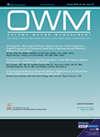A Descriptive, Cross-sectional Study Among Chinese Patients to Identify Factors that Affect Psychosocial Adjustment to an Enterostomy.
Q2 Nursing
引用次数: 17
Abstract
Physiological, psychological, and social problems may affect adaptation to living with a stoma. A descriptive, cross-sectional study was conducted between March 2017 and June 2017 among patients culled from a manufacturer's database to identify factors that influence psychosocial adjustment in Chinese patients with an enterostoma. Patients with a history of ostomy surgery ≥1 month prior and who were ≥18 years of age, completed a primary school education, and able to communicate in Chinese were eligible to participate unless they had a history of psychosis, cognitive impairment, or participation in other research programs. After providing informed consent, participants completed a questionnaire that addressed demographic (age, gender, employment, educational level, marital status, medical payment method, living status, and area of residence) and stoma-related (date of surgery, preoperative stoma siting, ostomy appliance type, peristomal complications, regular defecation, stoma self-care ability, stoma-related communication with medical staff, level of understanding regarding stoma knowledge and care skills, appliance change knowledge/experience, and leakage history) factors. Social support was assessed using the 10-item Social Support Revalued Scale (SSRS), and 3 dimensions of adjustment (acceptance, continuous worry, and positive life attitude) were assessed using the 20-item Chinese version of the Ostomy Adjustment Inventory (OAI). Questionnaires were administered via an online survey platform. Data were analyzed descriptively, and single-factor analysis and stepwise multiple linear regression were applied to identify the factors that influenced the adjustment level. Incomplete (missing >2 questions), incorrect, or hastily completed (within 600 seconds) records were excluded from analysis. Of the 1109 persons who returned the questionnaire, 1010 (91.1%) completed the entire survey (564 men [55.8%] and 446 women [44.2%], mean age 56.62 ± 15.62 years); 823 (81.5%) had a colostomy and 187 (18.5%) had an ileostomy. The OAI dimension continuous worry was negatively and significantly associated with all 3 dimensions of the SSRS, including subjective support (r = 0.259), objective support (r = 0.259), and utilization of support (r = 0.289), while the dimension acceptance was positively associated with both subjective support (r = 0.082) and objective support (r = 0.074) (all P values <.05). Using multiple linear regression, residence area, peristomal complication, regular defecation, leaking, self-care ability, communication with medical staff regarding ostomy, understanding knowledge or skill needed for stoma care, utilization of social support, and total score of social support were found to be significantly associated with ostomy adjustment level (all P values <.05). Patients living in an urban area, with no history of peristomal complications, who had regular defecation, had not experienced leaking, had better self-care ability, frequently communicated with medical staff, had a high level understanding about knowledge or skill of stoma, and had higher social support scores had higher adjustment scores. Knowledge of the factors that enhance or hinder adaptation of the patient to the ostomy is an important tool in the clinician's care armamentarium.在中国患者中进行的一项描述性横断面研究,以确定影响肠造口术后心理社会适应的因素。
生理、心理和社会问题可能影响对有造口生活的适应。在2017年3月至2017年6月期间,对从制造商数据库中挑选的患者进行了一项描述性横断面研究,以确定影响中国肠瘘患者心理社会适应的因素。有造口手术史≥1个月,年龄≥18岁,完成小学教育,能够用中文交流的患者,除非有精神病史、认知障碍或参与其他研究项目,否则符合参加条件。在提供知情同意后,参与者完成一份问卷,包括人口统计学(年龄、性别、就业、教育程度、婚姻状况、医疗支付方式、生活状况和居住地区)和造口相关(手术日期、术前造口位置、造口器具类型、口周并发症、定期排便、造口自我护理能力、与医务人员的造口相关沟通、对造口知识和护理技能的理解程度、电器更换知识/经验,以及泄漏历史)因素。采用10项社会支持重估量表(SSRS)评估社会支持,采用20项中文版造口适应量表(OAI)评估适应的3个维度(接受度、持续担忧和积极生活态度)。通过在线调查平台进行问卷调查。对数据进行描述性分析,采用单因素分析和逐步多元线性回归识别影响调整水平的因素。不完整(缺少>2个问题)、不正确或匆忙完成(在600秒内)的记录被排除在分析之外。在1109名回答者中,完成全部调查的1010人(91.1%),其中男性564人(55.8%),女性446人(44.2%),平均年龄56.62±15.62岁;结肠造口823例(81.5%),回肠造口187例(18.5%)。OAI维度持续担忧与主观支持(r = 0.259)、客观支持(r = 0.259)和支持利用(r = 0.289)三个维度均呈显著负相关,而维度接受与主观支持(r = 0.082)和客观支持(r = 0.074)均呈显著正相关(P值均< 0.05)。经多元线性回归分析发现,居住面积、口周并发症、排便规律、渗漏、自我护理能力、与医护人员的造口沟通、对造口护理知识或技能的了解、社会支持的利用、社会支持总分与造口调整水平有显著相关(P值均< 0.05)。生活在城市地区的患者,无肠周并发症史,排便规律,未发生漏尿,自理能力较好,与医护人员沟通频繁,对造口知识或技能了解程度较高,社会支持评分较高,适应评分较高。了解增强或阻碍患者适应造口术的因素是临床医生护理设备的重要工具。
本文章由计算机程序翻译,如有差异,请以英文原文为准。
求助全文
约1分钟内获得全文
求助全文
来源期刊

Ostomy Wound Management
医学-外科
CiteScore
0.99
自引率
0.00%
发文量
0
审稿时长
>12 weeks
期刊介绍:
Ostomy/Wound Management was founded in March of 1980 as "Ostomy Management." In 1985, this small journal dramatically expanded its content and readership by embracing the overlapping disciplines of ostomy care, wound care, incontinence care, and related skin and nutritional issues and became the premier journal of its kind. Ostomy/Wound Managements" readers include healthcare professionals from multiple disciplines. Today, our readers benefit from contemporary and comprehensive review and research papers that are practical, clinically oriented, and cutting edge. Each published article undergoes a rigorous double-blind peer review by members of both the Editorial Advisory Board and the Ad-Hoc Peer Review Panel.
 求助内容:
求助内容: 应助结果提醒方式:
应助结果提醒方式:


